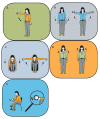Implementation of neck/shoulder exercises for pain relief among industrial workers: a randomized controlled trial
- PMID: 21936939
- PMCID: PMC3188479
- DOI: 10.1186/1471-2474-12-205
Implementation of neck/shoulder exercises for pain relief among industrial workers: a randomized controlled trial
Abstract
Background: Although leisure-time physical activity is important for health, adherence to regular exercise is challenging for many adults. The workplace may provide an optimal setting to reach a large proportion of the adult population needing regular physical exercise. This study evaluates the effect of implementing strength training at the workplace on non-specific neck and shoulder pain among industrial workers.
Methods: Cluster-randomized controlled trial involving 537 adults from occupations with high prevalence of neck and shoulder pain (industrial production units). Participants were randomized to 20 weeks of high-intensity strength training for the neck and shoulders three times a week (n = 282) or a control group receiving advice to stay physically active (n = 255). The strength training program followed principles of progressive overload and periodization. The primary outcome was changes in self-reported neck and shoulder pain intensity (scale 0-9).
Results: 85% of the participants followed the strength training program on a weekly basis. In the training group compared with the control group, neck pain intensity decreased significantly (-0.6, 95% CI -1.0 to -0.1) and shoulder pain intensity tended to decrease (-0.2, 95% CI -0.5 to 0.1, P = 0.07). For pain-cases at baseline (pain intensity > = 3) the odds ratio - in the training group compared with the control group--for being a non-case at follow-up (pain intensity < 3) was 2.0 (95% CI 1.0 to 4.2) for the neck and 3.9 (95% CI 1.7 to 9.4) for the shoulders.
Conclusion: High-intensity strength training relying on principles of progressive overload can be successfully implemented at industrial workplaces, and results in significant reductions of neck and shoulder pain.
Trial registration: NCT01071980.
Figures



References
-
- National Research Council; Institute of medicine. Musculoskeletal disorders and the workplase - Low back and upper extremities. Washington D.C.: National Research Council; Institute of medicine; 2001. ISBN-10: 0-309-07284-0.
-
- Ahlgren C, Waling K, Kadi F, Djupsjobacka M, Thornell LE, Sundelin G. Effects on physical performance and pain from three dynamic training programs for women with work-related trapezius myalgia. J Rehabil Med. 2001;12:162–169. - PubMed
Publication types
MeSH terms
Associated data
LinkOut - more resources
Full Text Sources
Medical

